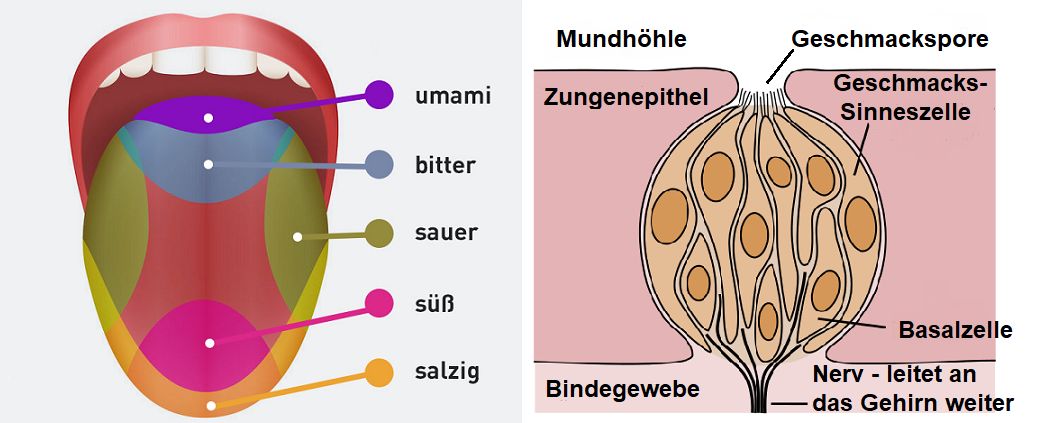Term of Japanese origin for the now scientifically recognised fifth taste sensation perceived by the presence of glutamate in food or drink. Chemically, glutamate is the sodium salt of the amino acid glutamine. Amino acids are the basic building materials for proteins. This substance develops flavour-enhancing properties in food and plays a special role in the palatability and acceptance of many foods. Glutamate (or glutamic acid) is found in almost all proteins as a building block, which means it is consumed with almost every meal. Vegetable proteins can even contain up to 40 % glutamic acid. However, glutamate must not be confused with gluten (gluten protein), to which some people are allergic.

In living cells, glutamic acid is necessary for detoxification processes and as an energy supplier, among other things. It is also the most important neurotransmitter for the transmission of stimuli between nerve cells. Only free glutamic acid or its salt functions as a flavour enhancer. In food seasonings such as Maggi or Knorr, the relevant proportion is glutamate. Particularly high glutamate concentrations are found in meat (especially in raw state like beef tartar), in human breast milk (22 mg/l), in ripe tomatoes (140 mg/l, in tomato paste four times that amount), in fish, in yeast, in soy and in cheese (in ripened Parmesan cheese even up to 1,200 mg/l). Pure glutamic acid itself tastes sweet-sour and intensifies the taste of salty foods. The use of these properties has a long tradition in Far Eastern cuisine.
Asian cooks used extracts from large algae (species Laminaria japonica) for food preparation more than 1,500 years ago. As early as 1908, the Japanese scientist Kikunae Ikeda (1864-1936) discovered that glutamate gives a full-bodied taste to protein-rich dishes. He called the taste direction "umami". This means "meaty, savoury and tasty" or is also a synonym for "greatest delicacy" or "pleasant taste" and is also understood in Japanese for an intensely experienced pleasure. Today, glutamate is used in many foods worldwide and has the ADI limit "not specified" according to the WHO. This means that it can be ingested by humans without restriction. For a long time, glutamate was said to cause the "Chinese restaurant syndrome" with symptoms such as headaches and nausea. However, this has not been confirmed in any way in double-blind trials.
In addition to the four traditional taste sensations bitter, salty, acid and sweet, umami was discovered in 2002 by the American scientists Charles Zucker and Nick Ryber at the MIT (Massachusetts Institute of Technology) as a fifth taste (in 2006, fatty was added as a sixth). Until then, it had been assumed that the sensation was merely a mixed taste of the other four. The receptors (nerve cells) responsible for the perception of glutamate were found in the taste buds of the tongue. And just as with the other four, there are cells in the brain that explicitly receive and reproduce umami.
Since wine contains amino acids, umami could also be objectively recognised if present. The only problem is that, according to the above studies, the receptors on the tongue are only weakly developed compared to the receptor sites in the brain (1 in 100). One phenomenon is that glutamate in combination with a wine containing bitter substances, as is the case with wines aged in barriques, for example, intensifies the bitter effect. This can be the case, for example, when eating Parmesan cheese or smoked salmon accompanied by wine aged in oak barrels.
Picture left (edited): Copyright: Peter Hermes Furian
Picture right (edited): By NEUROtiker - Own work, CC BY-SA 3.0, Link
Voices of our members

The Wine lexicon helps me to keep up to date and refresh my knowledge. Thank you for this Lexicon that will never end in terms of topicality! That's what makes it so exciting to come back often.
Thorsten Rahn
Restaurantleiter, Sommelier, Weindozent und Autor; Dresden